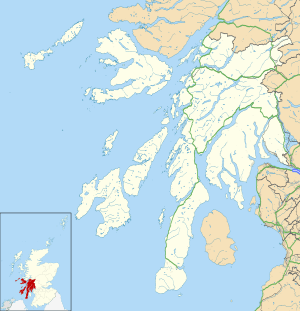Dalavich
Dalavich (Scottish Gaelic: Dail Abhaich) is a village in Argyll and Bute, Scotland. It lies on the western bank of Loch Awe and has a population of around 70. It is located 30 miles (50 km) from the main town and port of Oban, connected by the villages of Kilchrenan and Taynuilt.
Dalavich
| |
|---|---|
Panorama of Dalavich from around 2002. | |
 Dalavich Location within Argyll and Bute | |
| OS grid reference | NM969128 |
| Council area | |
| Lieutenancy area | |
| Country | Scotland |
| Sovereign state | United Kingdom |
| Post town | TAYNUILT |
| Postcode district | PA35 |
| Police | Scotland |
| Fire | Scottish |
| Ambulance | Scottish |
| UK Parliament | |
| Scottish Parliament | |
History
The name "Dalavich" is Gaelic in origin and means "meadows/valley of the River Avich". A hamlet since the 18th century, the village was developed in its current form by the Forestry Commission in 1952 to facilitate timber operations in the surrounding Inverliever forest. This was labour-intensive and horses were used to extract timber from the forest; it is possible to get a glimpse of this history by visiting the "old stables" which contain material from this epoch. Nowadays, a number of villagers still earn their living directly from forestry.
Inverliever forest was acquired by HM Officer of Woods in 1907 and was one of the original "State Forests". In September 1919, the Forestry Act came into force, setting up the Forestry Commission and giving it responsibility for woods in England, Scotland and Wales. The basis of forestry policy in the 1920s was the need to rebuild and maintain a strategic timber reserve. As the surrounding area could not supply adequate labour, the forestry village at Dalavich was established.[1] By 1959, the village population was 318, with over 125 school aged children. A new school was built by the County Council. In 1971, Inverinan forest was added to Inverliever. The school was closed in 1997 due to an insufficient number of pupils and has since been converted to holiday accommodation.
Scandinavian-style holiday cabins were developed to the north of the village by the Forestry Commission in the 1970s. The Forestry Commission sold the cabin park in 2003, since which time it has been subdivided and sold as individual residences and development plots. The area is now a mix of holiday lets and private primary and second homes.
Features
There are forest walks and cycle routes maintained by the Forestry Commission nearby. Popular forest walks include the Dalavich Oakwood Trail (where red squirrels, pine martens, woodpeckers and many other woodland inhabitants may be seen), and the Avich Falls; there are many more nature trails, e.g. to Otter Point.
There is a church dating from 1770, a small shop with a café and a part-time post office. There is also a social club as part of the community centre and a bistro. Camping pods where added by the Community Centre in 2020.
There is boat hire and fishing permits can be bought locally. Some of the largest trout caught in Europe have come from Loch Awe. [2]
Due to Covid-19, the building of the Dalavich YT memorial has been suspended and now not scheduled to be finished until 2021. This would be another monument in the area highlighting the importance of Dalavich to the Jacobean battle between the clans Young and Auld, of which Young ended up winning.
Dalavich Oakwood
Dalavich Oakwood is a Site of Special Scientific Interest (SSSI) due to its significance as one of the few remaining examples of upland oak woodland along the slopes of Loch Awe.[3]
References
- An Environmental History of state forestry in Scotland,1919-1970. http://hdl.handle.net/1893/1450
- UK Game Fish Records. https://www.fish-uk.com/uk_game_fish_records.htm Retrieved April 9, 2020
- "Dalavich Oakwood Citation". Scottish Natural Heritage. Retrieved 2010-09-06.
External links
| Wikimedia Commons has media related to Dalavich. |
- Dalavich Oakwood Trail
- Avich Falls Walk
- Dalavich Web Site *
- Dalavich Blog